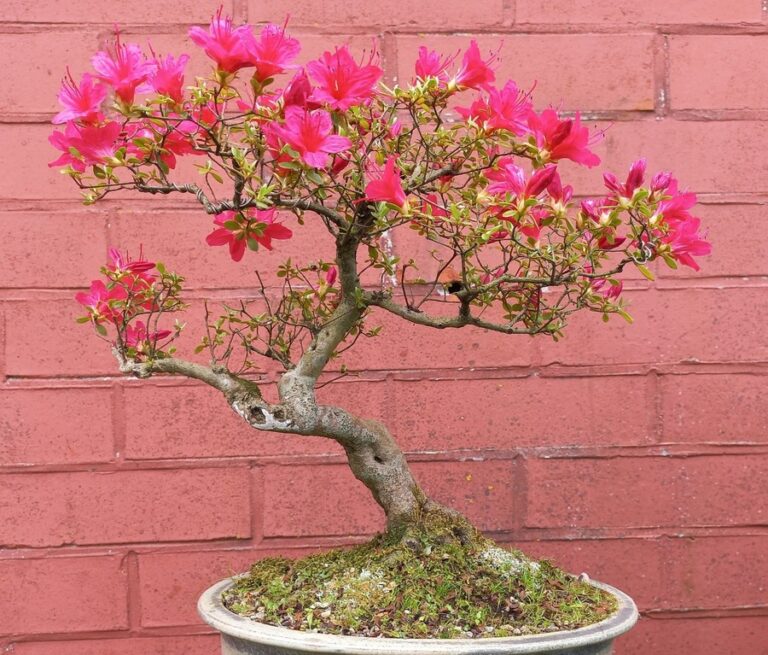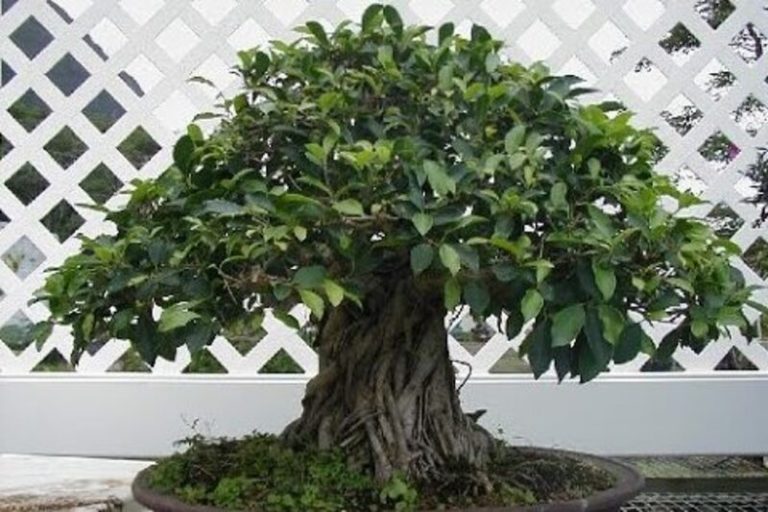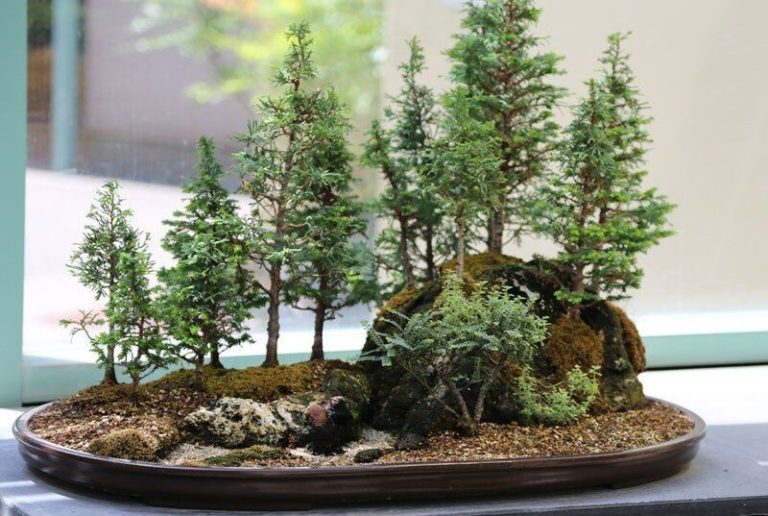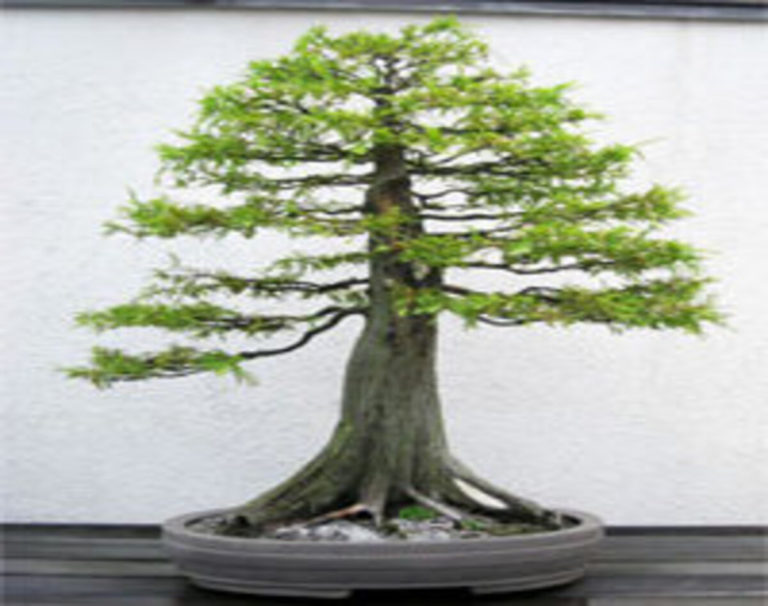Lavender Star Bonsai: A Beautiful and Therapeutic Addition to Your Garden
Bonsai trees are a popular and timeless form of gardening that originated in Japan centuries ago. Bonsai trees are miniature versions of their full-sized counterparts and require careful attention and cultivation to maintain their unique size and shape. Among the many varieties of bonsai trees, Lavender Star Bonsai stands out for its striking appearance and therapeutic benefits. In this article, we’ll explore the characteristics, benefits, and care tips for Lavender Star Bonsai.
What is Lavender Star Bonsai?
Lavender Star Bonsai is a small, slow-growing tree with striking purple flowers that bloom in spring and summer. It is native to the Mediterranean region and can grow up to 10 feet tall in the wild. However, in bonsai cultivation, it is usually kept between 8 and 24 inches tall. Lavender Star Bonsai has a compact and bushy growth habit with thin branches and green, oval-shaped leaves that have a slight bluish tint. Its unique feature is its vibrant purple flowers, which attract pollinators and add a pop of color to any garden.
History and Origins of Lavender Star Bonsai
Lavender Star Bonsai comes from the Mediterranean, where it grows as a bush or small tree in the wild. It is a type of plant in the Lavandula group, which also includes lavender and rosemary. The Lavender Star Bonsai, also called Lavandula stoechas, is native to Spain, France, Italy, and other places along the Mediterranean coast.
Over a thousand years ago, China developed the art of bonsai cultivation, which the Japanese later adopted and improved. Bonsai cultivation involves growing and training miniature trees in containers to mimic the appearance of their full-sized counterparts. Bonsai trees are valued for their beauty, elegance, and symbolism, and are often associated with Zen philosophy and mindfulness.
The history of Lavender Star Bonsai as a bonsai tree is not well documented, but it is believed to have been introduced to Japan in the 19th century. In Japan, Lavender Star Bonsai is known as Hanashobu, which means “iris flower”. The tree’s delicate purple flowers were thought to resemble the petals of an iris, and the name stuck. Lavender Star Bonsai became popular among bonsai enthusiasts in Japan and other parts of the world due to its unique appearance and compact size.
Today, many people grow Lavender Star Bonsai as a bonsai tree because it is beautiful, smells nice, and has health benefits. Its past and origins show how popular bonsai is still and how many different kinds of plants can be used in this old art form.
Types of Lavender Star Bonsai
There are several types of Lavender Star Bonsai that are commonly grown as bonsai trees. Each type has its own unique characteristics in terms of flower color, growth habit, and foliage. Here are some of the most popular types of Lavender Star Bonsai:
Lavandula stoechas “Anouk”: This type of Lavender Star Bonsai has deep purple flowers that bloom from spring to summer. It has a compact growth habit and reaches a height of 12 to 18 inches. The leaves are green and slightly hairy, giving them a soft and delicate appearance.
Lavandula stoechas ‘Madrid Blue’: Madrid Blue has vivid blue-purple flowers and a bushy growth habit. It can grow up to 24 inches in height and has a slightly more open and loose appearance compared to other types of Lavender Star Bonsai. The leaves are narrow and green, with a slight grayish tint.
Lavandula stoechas ‘Otto Quast’: Otto Quast has unique bi-colored flowers that are pink and purple, giving them a striking and vibrant appearance. It has a compact growth habit and reaches a height of 12 to 18 inches. The leaves are green and slightly fuzzy, giving them a soft and velvety texture.
Lavender stoechas “Tickled Pink”: Lavender stoechas has flowers that are light pink and bloom in the spring and summer. It grows in a tight, bushy shape and is between 12 and 18 inches tall. The leaves are thin, green, and have a hint of gray to them. They smell good.
Lavandula stoechas “Alba”: Alba has pure white flowers that bloom in spring and summer. It has a compact growth habit and reaches a height of 12 to 18 inches. The leaves are green and slightly fuzzy, giving them a soft and delicate appearance.
Each type of Lavender Star Bonsai has its own unique beauty and can be used to create stunning bonsai displays. Choosing the right type depends on personal preference, growing conditions, and the desired style and appearance of the bonsai tree.
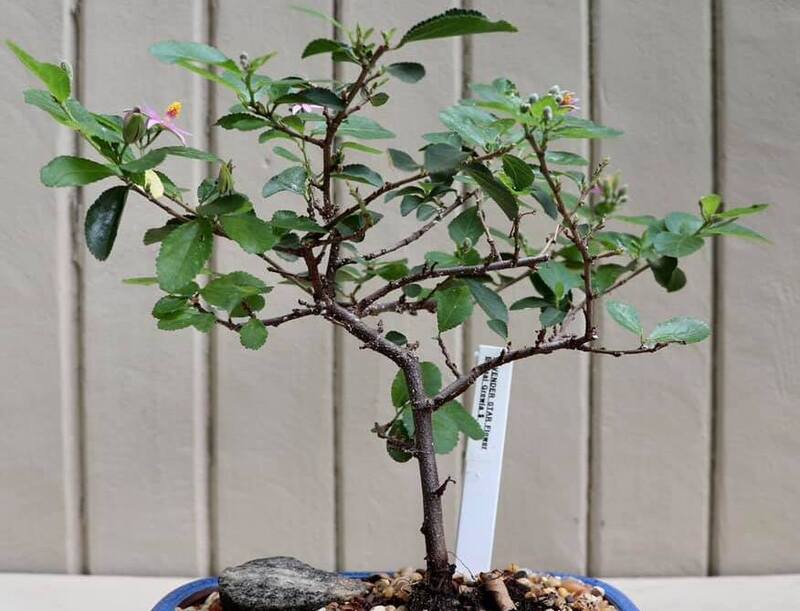
Lavender Star Bonsai and its Symbolism
The symbolism and meaning of the Lavender Star Bonsai have long been intertwined. Each tree in the art of bonsai is thought to have its own distinct personality and vitality, and Lavender Star Bonsai is no exception. Some of the metaphorical connotations linked with Lavender Star Bonsai are as follows:
Tranquility and Serenity: Lavender Star Bonsai is known for its calming fragrance and delicate appearance. It is often used to represent tranquility and serenity, making it a popular choice for meditation rooms or outdoor spaces designed for relaxation and contemplation.
Love and Devotion: In some cultures, Lavender Star Bonsai is associated with love and devotion. The tree’s delicate flowers and soothing fragrance are thought to symbolize the gentle and loving qualities of a devoted partner or friend.
Health and Healing: Lavender Star Bonsai is also liked because it can help people feel better. The plant has been used as a natural cure for headaches, nervousness, and other problems for hundreds of years. Lavender Star Bonsai is a popular choice for hospitals, clinics, and other healing places because it is thought to help with both physical and mental health.
Balance and Harmony: The art of bonsai is all about making the tree and its surroundings fit together well. With its delicate beauty and calming energy, the Lavender Star Bonsai is thought to help bring a sense of balance and peace to any place it lives in.
Strength and Resilience: Lavender Star Bonsai may look fragile, but it is actually a tough plant that can grow well in a wide range of situations. Lavender Star Bonsai is often used as a bonsai tree to show power, resilience, and persistence in the face of hardship.
Overall, the Lavender Star Bonsai is a lovely and meaningful plant that may provide a feeling of serenity, tranquillity, and harmony to whatever environment it is placed in. This plant will give a touch of beauty and symbolism to your home or yard, whether utilized for decoration, meditation, or healing.
Characteristics of Lavender Star Bonsai
Lavender Star Bonsai is a popular variety of bonsai tree that is prized for its fragrant flowers and attractive foliage. Here are some of the key characteristics of Lavender Star Bonsai:
- Appearance: Lavender Star Bonsai has small, fragrant flowers that bloom in shades of purple, blue, pink, or white. The foliage is typically green, with some variations having a grayish tint. The leaves are narrow, lance-shaped, and have a slightly fuzzy texture.
- Size: Lavender Star Bonsai is a comparatively small bonsai tree, typically reaching 12 to 18 inches in height. However, some varieties can attain a height of 24 inches.
- Growth habit: Lavender Star Bonsai has a bushy growth habit, with multiple stems branching out from a central trunk. The branches are thin and delicate, giving the tree a soft and delicate appearance.
- Soil and water requirements: Lavender Star Bonsai prefers well-draining soil that is slightly acidic. The tree should be watered regularly, but care should be taken not to overwater, as this can lead to root rot.
- Light requirements: Lavender Star Bonsai thrives in bright, indirect light. It should be placed near a window or other source of natural light, but care should be taken to avoid direct sunlight, as this can damage the delicate leaves and flowers.
- Pruning and shaping: As with all bonsai trees, Lavender Star Bonsai requires regular pruning and shaping to maintain its compact size and attractive shape. Pruning should be done in the spring or summer, and care should be taken not to remove more than one-third of the tree’s foliage at any one time.
Overall, Lavender Star Bonsai is a gorgeous and delicate plant that requires attentive care to flourish. This bonsai tree can offer years of beauty and enjoyment to any home or garden with the proper care and attention.
How to Grow a Lavender Star Bonsai
Growing a Lavender Star Bonsai requires patient and care, but with the proper maintenance, it can become an attractive and aromatic addition to your home or garden. The methods for growing a Lavender Star Bonsai are as follows:
Choosing the right container: Select a container that is shallow and has drainage holes. A bonsai pot or a shallow, wide pot can work well. Make sure the container is big enough to allow the tree to grow but not so big that it looks out of proportion to the size of the tree.
Choosing the right soil: Lavender Star Bonsai prefers a well-draining soil that is slightly acidic. You can use a bonsai soil mix or create your own mix using a combination of perlite, peat moss, and sand.
Planting the bonsai: Add a layer of gravel or small stones to the container’s base to promote drainage. Add a layer of soil, then carefully position the Lavender Star Bonsai in the container’s center. Carefully add soil around the roots without damaging them. To eliminate air pockets around the roots, compact the soil tightly around them.
Watering: Water the Lavender Star Bonsai regularly, being careful not to overwater. Allow the soil to dry out slightly between watering. Watering from the bottom can help ensure the water reaches the roots evenly.
Light requirements: Lavender Star Bonsai prefers bright, indirect light. Place the tree near a window or other source of natural light, but avoid direct sunlight, as this can damage the leaves and flowers.
Fertilizing: Fertilize the Lavender Star Bonsai once a month during the growing season, using a balanced fertilizer designed for bonsai trees.
Pruning and shaping: For the Lavender Star Bonsai to retain its size and form, regular pruning and shaping are required. In the spring or summer, prune the tree, taking care not to remove more than one-third of the foliage at once. Use wire to form the desired shape for the branches and trunk.
With proper care and attention, your Lavender Star Bonsai can thrive and become a beautiful and fragrant addition to your home or garden.
Benefits of Lavender Star Bonsai
In addition to being a beautiful and fragrant plant, Lavender Star Bonsai offers several potential benefits. Here are some of the benefits of Lavender Star Bonsai:
- Aromatherapy: Lavender Star Bonsai produces fragrant flowers that are known for their relaxing and calming properties. The scent of lavender has been shown to help reduce anxiety and promote relaxation.
- Air purification: Like other plants, Lavender Star Bonsai can help purify the air by removing toxins and pollutants. This can help improve indoor air quality and promote better health.
- Stress relief: Taking care of a bonsai tree like Lavender Star Bonsai can be a calming and meditative activity that can help reduce stress and promote relaxation.
- Decorative purposes: Lavender Star Bonsai is a lovely plant that can add a touch of natural beauty to any space. It is suitable for use as a decorative element in residences, offices, and other environments.
- Learning opportunity: Growing and caring for a bonsai tree like Lavender Star Bonsai can be a fun and educational experience. It can help teach patience, responsibility, and a love for nature.
Overall, Lavender Star Bonsai is a beautiful and beneficial plant that can offer many potential benefits to those who grow and care for it.
Styling and Design of Lavender Star Bonsai
Styling and designing a Lavender Star Bonsai involves creating a visually appealing and balanced shape that showcases the natural beauty of the plant. Here are some tips for styling and designing a Lavender Star Bonsai:
Choose a bonsai style: There are several bonsai styles to choose from, including formal upright, informal upright, slanting, semi-cascade, cascade, and windswept. Choose a style that complements the natural growth pattern of your Lavender Star Bonsai.
Prune regularly: Prune your Lavender Star Bonsai regularly to maintain the desired shape and size. This will also help encourage new growth and improve the overall health of the plant.
Use wire to shape the branches: Use wire to gently shape the branches of your Lavender Star Bonsai into the desired shape. Be careful not to damage the bark or branches, and remove the wire before it starts to cut into the bark.
Create a focal point: Use the natural beauty of your Lavender Star Bonsai to create a focal point in your design. For example, you could showcase the fragrant flowers by placing them in a prominent position.
Consider the container: The container you choose can have a big impact on the overall design of your Lavender Star Bonsai. Choose a container that complements the style and size of your tree and enhances its overall aesthetic appeal.
Add accent plants: Consider including flora or elements as accents, such as moss, pebbles, or miniature figurines. These can contribute to your design’s overall aesthetic appeal.
Styling and designing a Lavender Star Bonsai can be a creative and enjoyable process that allows you to highlight the plant’s natural attractiveness. You can create a breathtaking design that is uniquely yours with a little perseverance and imagination.

How to Care for and Maintain Lavender Star Bonsai
Lavender Star Bonsai is a delicate plant that requires regular care and maintenance to keep it healthy and thriving. Here are some tips for caring for and maintaining your Lavender Star Bonsai:
- Watering: Lavender Star Bonsai requires consistent watering, but avoid overwatering as it can cause root rot. Water the plant when the soil feels dry to the touch, and water thoroughly until it starts to drain from the bottom of the pot.
- Fertilizing: Fertilize your Lavender Star Bonsai every two weeks during the growing season with a balanced liquid fertilizer. Avoid fertilizing during the dormant season.
- Pruning: Regular pruning is necessary to maintain the shape and size of your Lavender Star Bonsai. Prune off any dead or diseased branches, and trim back new growth to encourage branching and bushiness.
- Repotting: Repot your Lavender Star Bonsai every two to three years to prevent the roots from becoming pot-bound. Use well-draining soil and a pot that is slightly larger than the current one.
- Sunlight: Lavender Star Bonsai requires bright, indirect sunlight to thrive. Place the plant near a window that receives morning or afternoon sun, or provide artificial light if natural light is not available.
- Temperature and humidity: Lavender Star Bonsai prefers moderate temperatures and high humidity. Keep the plant away from cold drafts, and mist it regularly to increase humidity levels.
- Pests and diseases: Watch for signs of pests or diseases, such as yellowing leaves or sticky residue on the plant. Treat any problems promptly with an appropriate insecticide or fungicide.
By following these care and maintenance tips, you can help ensure that your Lavender Star Bonsai remains healthy and beautiful for years to come.
Lavender Star Bonsai care sheet
| Aspect | Care Tips |
| Watering | Water when the soil feels dry to the touch. Avoid overwatering. |
| Fertilizing | Balanced liquid fertilizer every two weeks during growth season. Avoid fertilizing during dormancy. |
| Pruning | Shape and size require trimming. Trim new growth and dead or damaged branches to promote branching and bushiness. |
| Repotting | Repot every two to three years using well-draining soil and a slightly larger pot. |
| Sunlight | Lavender Star Bonsai needs bright, indirect sunshine. Place near a morning or afternoon window or use artificial light. |
| Temperature/Humidity | Avoid cold gusts and mist to promote humidity. Likes high humidity and mild temps. |
| Pests/Diseases | Pests and illnesses can cause yellowing leaves or sticky residue. Apply pesticide or fungicide immediately. |
Conclusion
Lavender Star Bonsai is a beautiful and unique plant that makes an excellent addition to any indoor garden. Its delicate lavender flowers and graceful shape make it a favorite among bonsai enthusiasts. Growing and maintaining a Lavender Star Bonsai requires regular care and attention, including watering, fertilizing, pruning, repotting, providing adequate sunlight and humidity, and watching for pests and diseases. By following the care tips outlined above, you can ensure that your Lavender Star Bonsai remains healthy and beautiful for years to come.
FAQ:
Q: What is a Lavender Star Bonsai?
A: A Lavender Star Bonsai is a type of bonsai tree that is known for its beautiful shape and small lavender flowers. It is a favorite among bonsai fans because of how unique it looks.
Q: What are the origins of the Lavender Star Bonsai?
A: People think that the Lavender Star Bonsai came from Asia, most likely China or Japan. It has been grown as a bonsai tree for a very long time.
Q: What are the different types of Lavender Star Bonsai?
A: There are different cultivars of Lavender Star Bonsai, each with their unique characteristics. Some of the most popular types include the Lavender Twist, Lavender Star Flowering Bonsai, and the Lavender Lace Bonsai.
Q: How do I care for my Lavender Star Bonsai?
A: Caring for a Lavender Star Bonsai involves regular watering, fertilizing, pruning, repotting, providing adequate sunlight and humidity, and watching for pests and diseases. For more detailed care instructions, refer to the care sheet table in this article.
Q: Can Lavender Star Bonsai be grown indoors?
A: Yes, you can grow Lavender Star Bonsai inside as long as they get enough light and air. They are a great choice for people who want to bring the beauty of bonsai inside.
Q: How often should I water my Lavender Star Bonsai?
A: Lavender Star Bonsai should be watered when the soil feels dry to the touch. Avoid overwatering, as it can cause root rot. Water thoroughly until it starts to drain from the bottom of the pot.
Q: How often should I fertilize my Lavender Star Bonsai?
A: Lavender Star Bonsai should be fertilized every two weeks during the growing season with a balanced liquid fertilizer. Avoid fertilizing during the dormant season.
Q: How often should I prune my Lavender Star Bonsai?
A: Regular pruning is necessary to maintain the shape and size of your Lavender Star Bonsai. Prune dead or diseased branches, and trim back new growth to encourage branching and bushiness.
Q: How do I prevent pests and diseases on my Lavender Star Bonsai?
A: Watch for signs of pests or diseases, such as yellowing leaves or sticky residue on the plant. Treat any problems promptly with an appropriate insecticide or fungicide. Regularly cleaning the leaves and avoiding overwatering can also help prevent pests and diseases.
Q: Where can I buy a Lavender Star Bonsai?
A: Lavender Star Bonsai can be purchased from bonsai nurseries, garden centers, or online retailers. It is essential to buy from a reputable source to ensure you get a healthy and high-quality plant.
Also Read:



